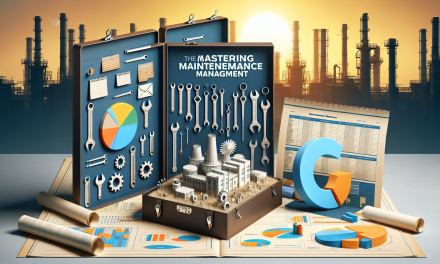Table of Contents
- Introduction
- The Importance of Decision Analysis
- Understanding the Decision-Making Process
- Key Factors in Decision Analysis
- Tools and Techniques for Decision Analysis
- Best Practices in Maintenance Management
- Frequently Asked Questions
- Conclusion
Introduction
In today’s fast-paced operational environment, professionals in operations and maintenance must make informed decisions quickly. Leveraging decision analysis can significantly enhance your effectiveness in managing maintenance tasks and operational efficiencies. This blog post explores decision analysis, focusing on how it can empower maintenance management.
The Importance of Decision Analysis
Decision analysis, in its essence, involves a systematic approach to evaluating decisions so that you can identify the best possible options. For operation and maintenance professionals, this is crucial because:
- Enhances Decision-Making: Structured decision-making processes support better outcomes.
- Reduces Risks: Through thorough evaluation, you can pinpoint potential risks and mitigate them effectively.
- Increases Efficiency: Implementing decision frameworks streamline operations, reducing downtime.
- Improves Resource Allocation: By understanding decision impacts, resources can be utilized more effectively.
Understanding the Decision-Making Process
Effective decision-making is not just about choosing what seems right; it involves a detailed understanding of various interconnected factors. Typically, the decision-making process consists of the following steps:
1. Identify the Problem
Recognizing the issue is the first step. It sets the foundation for all future actions and decisions. A well-defined problem leads to more accurate analysis.
2. Gather Information
Next, collect relevant data that impacts the problem. This may involve metrics from past maintenance tasks, feedback from team members, and operational reports.
3. Evaluate Options
Consider the different alternatives available. Weigh the pros and cons involving resource consumption, time efficiency, and potential outcomes.
4. Make the Decision
Once all options have been evaluated, select the strategy that aligns best with your operational goals.
5. Implement the Decision
With a decision made, it’s time to put that plan into action. Ensure that communication channels are clear so that all team members understand their roles.
6. Review and Reflect
Finally, review the outcomes to understand what worked well and what didn’t. This step is vital for continuous improvement.
Key Factors in Decision Analysis
Several key factors play a critical role in effective decision analysis. Understanding these factors enhances your ability to make sound decisions.
Data Quality
The quality of the data you gather significantly impacts your decisions. Accurate and up-to-date data leads to better-informed choices.
Stakeholder Involvement
Involving stakeholders and team members can bring valuable insights. Collaborating with others can unveil perspectives that you may overlook.
Scenario Planning
Scenario planning involves imagining various future scenarios. This helps you prepare for possible changes in the operational landscape.
Tools and Techniques for Decision Analysis
A plethora of tools can assist in the decision analysis process. Utilizing these tools can simplify complex analyses:
1. Decision Trees
These visual representations outline different decision paths, helping visualize potential outcomes.
2. Cost-Benefit Analysis
This technique provides a straightforward comparison of costs versus benefits, offering clarity in decisions.
3. SWOT Analysis
Identifying Strengths, Weaknesses, Opportunities, and Threats allows professionals to assess situations comprehensively.
4. Simulation Models
Simulation models help predict how different variables can impact outcomes, leading to informed decision-making.
Best Practices in Maintenance Management
Effective maintenance management hinges on several best practices. By following these guidelines, you can optimize decision-making processes:
Establish Clear Objectives
Establishing clear, measurable objectives ensures everyone on your team understands their goals.
Regular Training and Development
Investing in regular training and development for your team can help keep everyone updated on best practices and industry trends.
Utilize Technology
Modern technology such as Decision Analysis in Operations: Enhance Maintenance Management empowers maintenance professionals to streamline processes and enhance effectiveness.
Continuous Improvement
Always look for ways to improve by analyzing past decisions and implementing best practices from industry leaders, found in articles like Mastering Effective Maintenance Management Techniques or Mastering Maintenance Management Best Practices for Success.
Frequently Asked Questions
What is Decision Analysis in Operations and Maintenance?
Decision analysis in operations and maintenance refers to systematic evaluation and assessment of various decisions that affect operational efficiency and maintenance management.
How can Decision Analysis improve maintenance management?
By utilizing structured methods, decision analysis enhances decision-making processes, helps identify risks, and improves resource allocation. This leads to higher efficiency and better overall performance.
Conclusion
In conclusion, decision analysis is an essential skill for operation and maintenance professionals. By following a systematic decision-making process and utilizing various tools and techniques, you can significantly enhance your maintenance management. Furthermore, by adopting best practices and focusing on continuous improvement, you can ensure operational excellence. For more insights on maintaining effective practices, check out Mastering the Art of Writing Effective Maintenance Procedures for Enhanced Operational Efficiency, Elevate Your Skills with Maintenance Audit and Site Inspection Insights, and Unlocking Maintenance Reliability: Asset Management Technology Best Practices for Operational Excellence.





